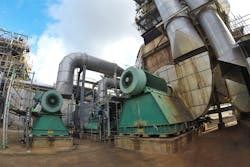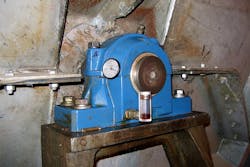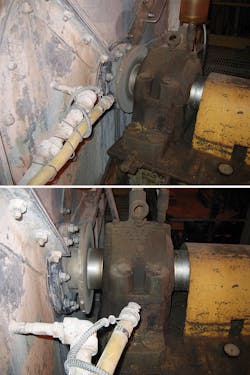Maximize uptime with these fan and blower bearing solutions
Fans and blowers are not difficult pieces of equipment to understand or troubleshoot, yet they create a lot of unexpected downtime for many end users. This downtime is expensive for production facilities. Many of the reliability issues are due to the selection of pillow block styles, internal bearings, seals and lubrication choices as well as the lubrication delivery systems. This article discusses ways to avoid common pitfalls involved in selection and how to make solid decisions to fix issues faster or specify the proper parts from the OEM at the start of the project.
Proper pillow block selection options
Picking the right pillow block style is the key to success for any fan and blower. Many OEMs tend to pick the lowest-cost unit, which is not always the best for the application. If all design engineers had to spend time in the field fixing what they designed, this article would not be necessary. This is not a knock on the OEMs, as their number one objective is to win the order. However, if the end user does not have a specification, or cost is the only focus, then it could result in getting the wrong components. It is the old rule of life, "Pay me now or pay me later."
Pillow block. Image courtesy of Motion Industries Canada
The best standard housings for fans or blowers to be used in North America are the SAF and SAFD blocks. These are blocks with larger lubrication reservoirs and labyrinth style seals. SNH or SNL blocks are more common in Europe, where they were developed. In Europe, the SNL style with forced oil lubrication and special seals are used, which works well and is reliable. In North America, grease is more commonly used (more on this topic later).
The SNL is the newer version of the SNH and typically uses a lip-seal, which is not ideal for higher shaft speeds. High shaft speeds are typical on fans and blowers. Also, the SNL unit is grease-only, unless a forced oil system is used. The SNL block is better-suited for low-speed conveyors, not high-speed fans or blowers.
Many other styles of pillow blocks are well-suited for fan and blower blocks, such as the Dodge Sleeveoil, SKF PDN and SONL. These three styles are considered high-end pillow blocks, which are almost always oil lubricated.
CARB bearing. Image courtesy of SKF
CARB toroidal roller bearings for fans & blowers
CARB was invented by SKF in the early 1990s. The industry has quickly adjusted to using one CARB (floating) and one double-row spherical bearing (fixed) instead of two double-row spherical bearings on each side for fans and blowers. The CARB is a toroidal roller bearing that can axially adjust (to accommodate thermal shaft growth) without having to slide the outer race axially in the housing. This allows the use of tighter pillow block housing specifications (K7), which reduce system vibration issues.
Double-row, self-aligning ball bearings
Having this style bearing in smaller fans and blowers is common. It is also common for the designer to select a taper-lock style, which is more prone to failure. If repeat failure on this style bearing with a "K" lock occurs, then examine the inside of the outer race where the balls ride. If it has a load zone 360 degrees around the bearing race (both ball paths), then too much clearance was taken out of the bearing during the installation. This is considered an installation error but it could also be considered a case of misapplied technology. The issue results because a feeler gauge cannot be used with a double-row ball bearing as it can with a double-row spherical style bearing. So, the installer is left with a set of ambiguous instructions that suggest the starting point is "hand tight." The problem is everyone has a different sized hand with different strength. The only way to properly install this taper-lock style double-row ball bearing is to use the hydraulic lock nut method.
Another solution for the OEM is to use a straight- bore mount if a double row ball bearing design is necessary due to low loads. The straight shaft will be more expensive for the OEM to build and design but the final mount is not a guessing game for the installer. The shaft would now have steps. Both the SAF and SAFD style block are built for step shafts and straight- bore mount bearings but are not commonly used.
Seals
The best seal for high-speed fans and blowers is a noncontact labyrinth style seal. All SAF and SAFD pillow blocks come with this style seal as standard. Avoid any lip seal style as the lip drags on the shaft surface, which causes heat and shaft wear. Avoid extra heat when possible.
Today, many seal manufacturers offer custom labyrinth style seals to fit all common SAF and SAFD pillow blocks.
Now that a few common styles of blocks, bearings and seals have been covered, it is important to discuss the most vital component of any fan and blower pillow block assembly: lubrication. This is the life blood of the design. It is imperative to select the proper lubrication and the proper lubrication delivery system.
Never direct cold air to outside of hot bearing housing. Direct the cold air toward the shaft or inner ring as shown in the bottom photo. Image courtesy of Motion Industries Canada
Lubrication: Grease versus oil
Oil is a much better way to lubricate typical fans and blowers for the following reasons:
When oil is being used along with the correct style sight glass, the level and condition of the oil is always known.
If necessary, this oil can be changed on the run.
With grease, the machine needs to be stopped early to take out the used grease, then the housing must be recharged and the bearing packed with new grease.
Oil samples can be taken without shutting down the unit.
Pillow blocks lubricated with oil will run cooler than ones with grease.
Bearings can run at higher speeds when oil is lubricated.
Oil lubricates better than grease in colder temperatures.
Oil is a better lubricant than grease in a minimum load condition. Oil doesn’t resist the rolling elements as much as grease so there is less skidding.
Often adding new grease is a guess, so too much grease gets pushed in, which causes a hot running bearing or a failure.
The most common complaint when using oil is that it is "messy." Whenever this occurs, the problem is traced back to one of following conditions:
- Using the wrong housing
- Using the wrong seals
- Using an automatic oiler meant for pumps, not pillow blocks
- Not understanding there are two oil levels in this style pillow block (dynamic and static)
- Using the wrong style sight glass with no viewable area for the oil
Oil delivery systems
Oil can be automatically dripped in when the machine is running. Often there is no need for this. A SAF and SAFD have an oil reservoir large enough to run with a wet sump for most applications.
If the pillow block is running hot due to speed or process shaft temperature, one of two methods of lubrication can be used: oil recirculation or oil mist.
Both methods are excellent when heat needs to be conveyed away from the bearings. Another option is running a dry sump, which lowers the bearing running temperature even further. For most operations, end users want the extra protection of a wet sump. Once all the conditions are known, the reliability engineer and the bearing supplier can team up and provide a tailored solution that everyone is comfortable with.
Cooling pillow blocks with air
Using air to cool the outside of a pillow block is the most common mistake made in the field and is a difficult mistake to correct. Usually operations staff will run air (or even water) to the outside of a pillow block to reduce the temperature of the bearings. In fact, what they are doing is increasing the internal temperature by reducing the running clearance of the bearings.
The heat is generated from the inner ring of the bearing, which causes the shaft and inner ring to expand. The heat is then transferred to the outer ring and the pillow block housing, which will also cause them to expand. If the outer housing is cooled with cold air, this expansion will be restricted, causing more internal heat. If air must be used, direct it toward the shaft, not the housing.
Conclusion
Engaging an experienced third party is suggested to discuss any serious bearing issue, but the solutions addressed in this article can help reliability teams pinpoint some obvious issues with the selection of components, as well as ways to avoid common pitfalls.
Nick Agius is a rotating equipment specialist for Motion Industries Canada, and has more than 40 years of experience with solving fan and blower bearings issues. His Anti-Rotation Device (ARD) solution for Canada and the U.S. was first patented in 1996, followed by two other patents. Visit motionindustries.com or for industrial training opportunities, visit motioninstituteonline.com.






